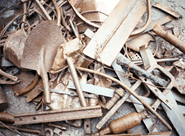Scrap Prices North America

Big Drop Expected for Ferrous Scrap Prices in January
Written by Tim Triplett
January 8, 2022
Ferrous scrap prices in the Midwest saw a big $60 drop in early trading for January – a surprise in a month that historically sees scrap prices rise. While trading continues in other regions, sources tell Steel Market Update they expect the market to settle in the next few days at down $40-50/GT for obsolete grades and down $50-60/GT for primes.
![]()
“I think this is the weakest January ferrous market in history, certainly on a dollar drop basis from December,” said one dealer in the North. “Obviously prices are still well ahead of where they were in 2019 and 2020.”
The biggest reason for the drop is the discrepancy between export and domestic prices, said scrap executives. “U.S. prices are far above worldwide prices – especially Turkey – which turns the flow of scrap away from the coasts and into the domestic market. This price discrepancy also allows U.S. consumers to import scrap and scrap substitutes at a savings. Other reasons for the drop are a softening demand for steel and higher inventory levels. Most participants view this weakening market as short term as demand will stabilize as new capacity comes online,” said another dealer on the East Coast.
“U.S. shredded scrap has been trading at a premium to the global price, in particular the Turkey shred CIF price, so one of those had to move. In light of the Turkish lira situation and anemic demand for finished steel in Asia, it became obvious it was the U.S. price that needed to move lower,” said one source.
The export market appears to be bottoming with some marginally better demand in Turkey and Asia and relatively stable prices, he added. “But with massive cost inflation, Turkish mills don’t have anywhere near the metal margin room they had a few months ago to pay more for scrap. So, I see export trading in the current range for now.”
Scrap flows were strong in the U.S. in November and December, and mills bought ahead into the end of the year. So they were better stocked than normal for January and consequently had less appetite to buy than usual at this time of year, sources noted.
“Mill order books already have holes in them, which is evident in the lower lead times. COVID disruptions are causing mills to pull back their buys more than they normally would as their melt schedules become less certain,” commented one dealer.
“It’s highly unusual for a drop like this in January, but high prices for scrap have indeed brought out more tonnages. February is even money to be sideways,” predicted another exec.
Scrap prices are closely watched as a leading indicator of finished steel prices, which are already trending downward in the first quarter.
The last time prime scrap saw a big drop in the first quarter was in January-February 2015, following an oil price crash in late 2014. Prices for both steel and scrap subsequently fell for most of the balance of the year, according to SMU’s interactive pricing tool. And then, just as now, lower steel prices in the fourth quarter foreshadowed a drop in scrap prices in the New Year.
By Tim Triplett, Tim@SteelMarketUpdate.com

Tim Triplett
Read more from Tim TriplettLatest in Scrap Prices North America

HRC vs. scrap spread widens over $150/ton in March
The HRC vs. prime scrap spread increased again in March.

HRC vs. prime scrap spread increases in February
The price spread between hot-rolled coil (HRC) and prime scrap widened in February ahead of the implementation of President Trump’s tariffs on steel.
HRC vs. prime scrap spread narrows again in January
The price spread between hot-rolled coil (HRC) and prime scrap continued to narrow in January, according to SMU’s most recent pricing data. While SMU’s average HRC price edged down week over week (w/w), it rose compared to a month ago. The January price for busheling also increased from December. Our average HRC price as of […]

HRC vs. prime scrap spread flat in November
The price spread between hot-rolled coil (HRC) and prime scrap remained the same in November as both tags were at the levels seen a month earlier, according to SMU’s most recent pricing data.

HRC vs. busheling spread narrows slightly in October
The price spread between hot-rolled coil (HRC) and prime scrap narrowed marginally in October, according to SMU’s most recent pricing data.
